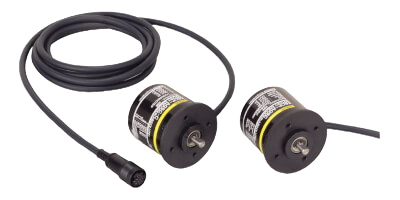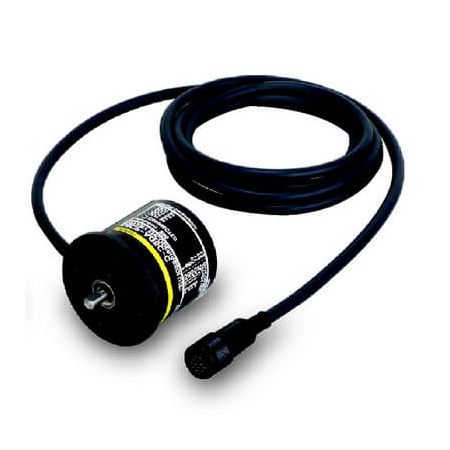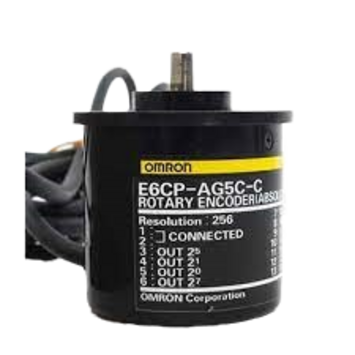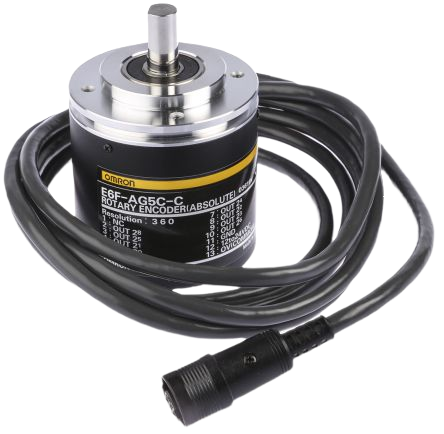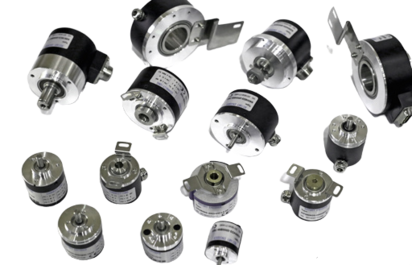Omron Encoders
omron e6c2
- Type: Incremental rotary encoder
- Diameter: 50 mm
- Shaft: Ø8 mm, Ø10 mm (optional)
Omron incremental encoder - E6C2-C Series
art. E6CP1009H
E6CP series
IN STOCK!!!
e6cp ag5c c encoder
- E6CP series, absolute
- 256ppr / 8-bit
- 12-24 VDC
- gray code output
- 2m cable
- H8PS connector
art. E6F 1010M
Encoder Omron E6F-A series
art. E6F 1036D
Omron Absolute Encoder E6F-A series
Omron incremental encoder
- IP protection: IP65, IP67
- Impact and vibration resistance
- Compliance CE, RoHS
In the realm of industrial automation, precision is paramount. Every movement, every operation must be executed with the utmost accuracy to ensure efficiency and productivity. This is where Omron Encoders shine, Omron, a global leader in automation technology, offers a comprehensive range of encoders designed to meet the demanding requirements of modern industrial applications.
Omron Encoders are sophisticated devices that are essential to provide correct comments on the position,encoder speed, and direction of rotating shafts or linear motion systems. They are widely employed to ensure precise control and monitoring of machinery and equipment in a variety of industries, including manufacturing, robotics, automotive, and aerospace.
At their core, encoders are sensors that translate movement from mechanical to electrical which are then interpreted by control systems to determine the position or movement of a rotating or linear object. Omron Encoders utilize advanced sensing technology to achieve high levels of accuracy and reliability in position detection.
How do Omron Encoders Work
Omron Encoders are essential components in industrial automation, playing a crucial role in providing precise feedback on the position, speed, and direction of moving parts. Understanding how Omron Encoders work is fundamental to grasping their significance in various industrial applications.
Principles of Operation
At the heart of Omron Encoders lies a simple yet ingenious principle: the conversion of mechanical motion into electrical signals. This process involves several key components working in tandem to accurately detect and relay position information.
- Encoder Disk: The encoder disk is a revolving part with marks or slots spaced uniformly apart. These marks or slots pass by a sensor as the disk rotates, producing electrical impulses.
- Sensor: The sensor is responsible for detecting changes in the position of the encoder disk. Optical, magnetic, or capacitive sensing technologies may be employed, contingent upon the particular kind of encoder.
- Signal Processing Circuitry: The encoder's circuitry then processes the signals that the sensor produces. The signals are interpreted by this circuitry, converting them into digital or analog outputs that represent position,encoder speed, and direction.
Types of Omron encoders
Omron offers a wide range of encoders that can be divided into two main categories
1. Incremental encoders
Generate a series of pulses each time the shaft is rotated by a fixed angle.
They do not provide information about the absolute position of the shaft, but only how much it has rotated since the last reset.
Models:
- e6c2 cwz5b: Compact incremental encoder with a resolution of 500 pulses per revolution.
- e6cp ag5c: General-purpose incremental encoder with a resolution of 256 to 65536 pulses per revolution.
- e6cp ag5c c: Incremental encoder in a ruggedized housing with a resolution of 256 to 65536 pulses per revolution.
2. Absolute encoders
Generate a unique code for each possible shaft position.
Provide information about the absolute position of the shaft, even if it has been turned off or reset.
Models:
- e6f ag5c c: Absolute encoder with a resolution of 256 or 360 pulses per revolution.
- e6f ag5c c 256 2m: Absolute encoder with 256 pulses per revolution and SSI interface.
- e6f ag5c c 360 2m: Absolute encoder with 360 pulses per revolution and SSI interface.
Benefits of Omron encoders
Omron encoders offer a number of benefits that make them an ideal choice for a wide range of industrial automation applications. Here are some of the key benefits
1. High accuracy
- Omron encoders are available in a wide range of resolutions, from 256 to 65536 pulses per revolution.
- This makes them ideal for applications where precise measurement is critical, such as CNC machine tools, robotics, and servo applications.
- Some models of Omron encoders have additional features, such as interpolation, that can further improve measurement accuracy.
2. Reliability
- Omron encoders are made of high quality components and are designed to work in harsh environments.
- They are resistant to shock, vibration, dust, and dirt, making them ideal for use in industrial environments.
- Omron encoders have a long service life and minimal maintenance requirements.
3. Wide range
- Omron offers a wide range of encoders to meet different application needs.
- Incremental and absolute encoders are available in a variety of resolutions, interface types, and housings.
- This makes it easy to select the Omron encoder that is ideal for your application.
4. Easy to install and use
- Omron encoders are easy to install and use.
- Many models come with mounting hardware and installation instructions.
- Omron encoders are compatible with a wide range of controllers and other automation equipment.
5. Additional features
- Omron encoders offer a number of optional features that can increase their functionality and versatility.
- Some models have built-in filters that improve noise immunity.
- Other models have position indicators or alarm outputs.
Encoders serve as essential components in industrial automation, ensuring accurate position feedback for optimal machinery performance. When navigating the selection process, seeking guidance from an expert is paramount. Eltra Trade's experienced managers are readily available to provide assistance and address technical inquiries, guaranteeing that you find the perfect encoder solution to meet your specific needs and requirements.


